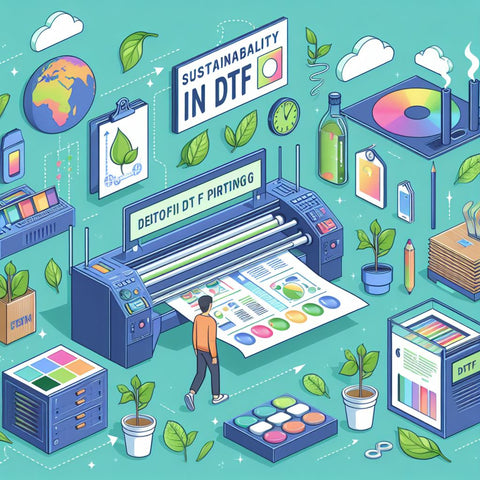As custom t-shirts continue to be a popular choice for individuals and businesses alike, the printing industry has evolved to meet the demand for unique and personalized designs. One method that has gained traction in recent years is Direct to Film (DTF) printing. While DTF printing offers many advantages in terms of quality and durability, it is essential to consider its environmental impact.
Understanding DTF Printing
DTF printing involves transferring designs from a special film onto fabric using heat and pressure. This process results in vibrant and long-lasting prints that are ideal for custom t-shirts and other apparel items. Compared to traditional methods, such as screen printing, DTF printing allows for greater detail and color accuracy.
The Advantages of DTF Prints
Custom t-shirts created using DTF transfers are known for their soft feel and vibrant colors. Additionally, DTF prints are highly resistant to fading and cracking, ensuring that your designs remain looking sharp and vivid for an extended period. This durability makes DTF printing a popular choice for businesses looking to create high-quality branded apparel.
The Environmental Concerns
While DTF printing offers numerous benefits in terms of print quality and longevity, it is important to address the environmental impact of this method. The use of special films and the energy-intensive process of heat transfer can contribute to waste and carbon emissions if not managed properly.
Sustainability in DTF Printing
Several steps can be taken to minimize the environmental impact of DTF printing. Choosing eco-friendly films and inks, as well as optimizing the printing process to reduce energy consumption, are effective ways to make this printing method more sustainable.
Recycling and Waste Management
Proper disposal of used films and other printing materials is essential in minimizing the waste generated by DTF printing. Recycling programs and waste management strategies can help ensure that these materials are handled responsibly and do not end up in landfills.
Carbon Footprint Reduction
Reducing the carbon footprint of DTF printing requires thoughtful planning and implementation of energy-efficient practices. By optimizing printing schedules, maintaining equipment properly, and investing in renewable energy sources, businesses can lower their environmental impact.
Benefits of Sustainable DTF Printing
Embracing sustainable practices in DTF printing not only benefits the environment but also enhances a company's reputation as a responsible and eco-conscious brand. Customers increasingly value businesses that prioritize sustainability, making sustainable DTF printing a competitive advantage.
Consumer Awareness and Education
As awareness of environmental issues continues to grow, consumers are becoming more discerning about the products they purchase. Educating customers about the sustainability efforts of DTF printing can help build trust and loyalty among environmentally conscious shoppers.
Collaboration for a Greener Future
Businesses in the DTF printing industry can collaborate with suppliers, manufacturers, and other stakeholders to develop innovative solutions for reducing the environmental impact of printing processes. By working together towards a common goal, the industry can achieve greater sustainability.
Looking Ahead: Sustainable Printing Practices
As the demand for custom t-shirts and personalized apparel continues to rise, the printing industry must adapt to meet this need while minimizing its environmental footprint. By adopting sustainable practices in DTF printing and embracing eco-friendly technologies, businesses can lead the way towards a greener future.
Embracing Sustainability in DTF Printing
In conclusion, while DTF printing offers unparalleled quality and durability for custom t-shirts and apparel, it is crucial to consider its environmental impact. By prioritizing sustainability, implementing eco-friendly practices, and educating consumers about the benefits of sustainable DTF printing, businesses can make a positive difference for the planet while meeting the demands of a growing market.





Comments (0)
There are no comments for this article. Be the first one to leave a message!